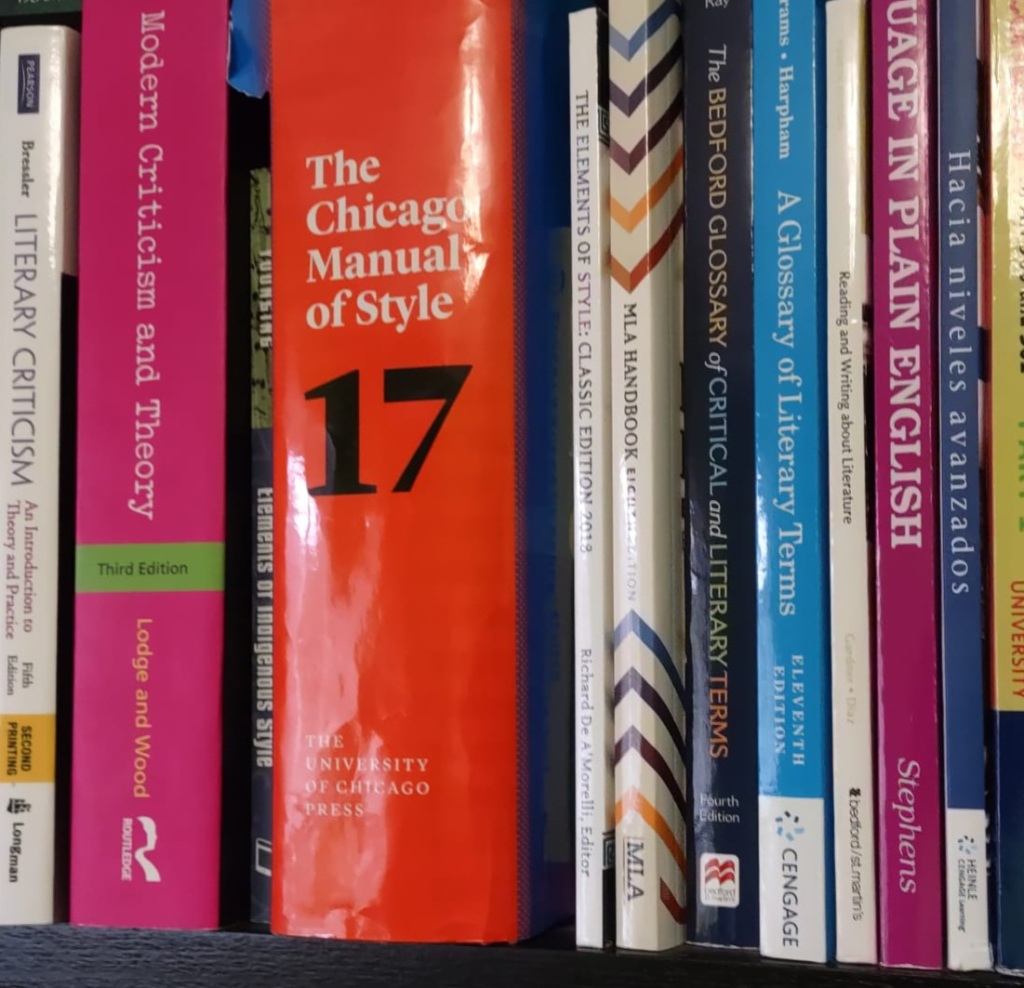In this column, members of the editing community share what’s on their (physical) bookshelves and highlight a few notable titles. In the past, our editors have shared such treasures as Storycraft, A Swim in a Pond in the Rain, and an entire shelf of Haruki Murakami titles. In this, our third instalment, editors in Vancouver, Toronto, and Nova Scotia share some of their favourites. If you’d like to show us your bookshelf, or part of it, let us know!
Bethany Lake is an editor, novelist, and playwright. Her bookshelf is in Mount Uniacke, Nova Scotia.

The top shelf on one of my many bookshelves is filled with everything from a book of letters as well as novels to short story collections, and, of course, editing resources. But nestled between Infinite Jest and The Chicago Manual of Style is a thin volume entitled Practically Painless English. Its placement on the shelf is not an accident. Rather, it provides the perfect bridge between one of the most commonly used style guides and David Foster Wallace’s 1996 encyclopedic masterwork. Practically Painless English (1980, Prentice-Hall, Inc.) is an English textbook written by Sally Foster Wallace, who was an English instructor at Parkland College in Champaign, Illinois. She was also David Foster Wallace’s mother.
Practically Painless English strives to be exactly that. Despite the fact that it is a textbook that would have been stocked in an average classroom and pored over by bored students in an afternoon English class, Wallace makes every attempt at making its subject matter at least fun, if not memorable, for the reader. Aside from containing the basics (the eight parts of speech and punctuation, plus whole sections devoted both to verbs and to pronouns, double negatives, and passive versus active voice), the book has an entire chapter entitled “Bits of Fascination” in which Wallace discusses parallelism, misplaced modifiers, and how the placement of “only” has the power to completely alter a sentence’s meaning. Most notably, the book contains as complete a list of irregular verbs and their tenses as I have ever seen.
It is obvious that Wallace had a great time writing this book. Her wacky sense of humour (which she clearly passed on to her son) comes across in her hilarious and delightfully weird sample sentences, as well as in the preface. She writes that the book is “a serious attempt to involve students in the beauty, logic, pizzazz, and joy of English.” Anyone who uses the word “pizzazz” to describe English grammar is my kind of person.
It’s a short book (208 pages) but chock full of quick answers to big grammatical questions. Practically Painless English is a surprisingly valuable resource, and I turn to it often. The only drawback to this book is that, as a rather old textbook, it has been long out of print. My own copy is a library discard with ATLANTA-FULTON PUBLIC LIBRARY stamped in red along the top pages. But if you can manage to locate a used copy online, get it. You won’t be sorry.
Natalia Iwanek (she/they) is a freelance editor and proofreader who spends time between Canada and Mexico. Her bookshelves are in Toronto, Canada, and Durango, Mexico.
I have several bookshelves spread over the continent, and I seem to create a new one each time I find myself in a new home. The thought of passing a second-hand bookstore without stopping in—and picking out a few books—fills me with dread.
Some of my editing-related favourites include classics, such as The Copy Editor’s Handbook by Amy Einsohn and Plain Language in Plain English by Cheryl Stephens.
I am increasingly drawn to understanding changes in language—and how language directly impacts our lived experiences. Various books and resources have inspired me along the way, as they question non-inclusive/outdated language and/or editing norms that can serve to perpetuate systemic oppression. I have learned a great deal from Elements of Indigenous Style: A Guide for Writing By and About Indigenous Peoples by Gregory Younging.
The rest of my bookshelf consists mainly of history and political science, with a specific interest in Latin American history and magical realism. I particularly enjoy the works of Carlos Fuentes, Miguel Ángel Asturias, James Baldwin, Fyodor Dostoevsky, Gabriel García Márquez, and Ben Okri.
Maya Klassen (she/her) is an ex-ballet dancer turned editor and wordsmith. Her bookshelf is in North Vancouver.

“If you aren’t interested in punctuation or are afraid of it, you’re missing out on some of the most beautiful, elegant tools a writer has to work with.” — Ursula K. Le Guin
A compelling and constructive book I’ve recently picked up is Steering the Craft: A 21st-Century Guide to Sailing the Sea of Story by Ursula K. Le Guin. In this guide, Le Guin prompts the reader to engage in short exercises created to help expand their craft. The exercises range from writing solely based on how the words sound coming out of your mouth (while avoiding rhyme or metre) to writing a paragraph without any punctuation in order to identify and assess any habits you may be unaware of.
A chapter precedes each exercise, relaying the thought process and inspiration behind them and illustrating their power with relatable and unique examples. It covers subjects like inconsistent points of view, how to hear your writing, “conjunctivitis,” and more—focusing on the fundamental components of narrative. This short and simple guide is helpful for writers and editors alike, challenging the reader to take a step back and assess their tools, looking at their own approaches through a new lens.
This article was copy edited by Ann Kennedy, a freelance copy editor and proofreader who lives in Toronto with her retired service dog, Rosa, by her side.

